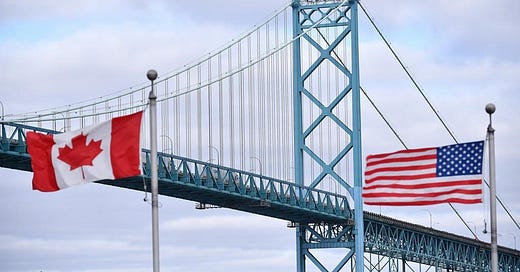Has Canada missed the boat on deeper integration with the United States?
Canada has been complacent for decades on its access to the United States. With the advent of Trump 2.0, complacency has been replaced by a sense of urgency, perhaps too late.
The recent announcement, by US President-elect Donald J. Trump, on his social media platform, Truth Social, that Canada and Mexico would face across-the-board tariffs of 25 percent, if they didn’t crack down on illegal migration and illegal drugs crossing into the United States, has set the cat amongst the pigeons in Ottawa and Mexico City — both policymakers and the commentariat.
Typical amongst the elite liberal commenting class in Canada has been a derisive dismissal that Trump’s threat of imposing tariffs may have any merit in promoting American interests, and such commentary is even more dismissive of Canadians who see some possible logic to this argumentation.
First off, let’s note that, if Trump 2.0 follows anything like the playbook of Trump 1.0 (that is not, of course, a certainty), then tariff announcements are not a fait accompli, but the first round in a negotiation process. Adam Smith, the founder of the modern (Anglo-American) discipline of economics, and a great acolyte for free markets and free trade, recognized that tariffs may be a tool that may be used to prise open foreign markets. (Indeed, the Joe Biden administration kept in place most Trump 1.0 tariffs against China, precisely to maintain leverage, as acknowledged by Biden’s USTR, Katherine Tai.) So, we shouldn’t assume that 25 percent tariffs are an inevitable outcome, if Canada (and Mexico) are able to play ball with the incoming Trump administration.
Indeed, Trump’s nominee as Secretary of the Treasury, the hedge fund billionaire Scott Bessent, explicitly made the case for the use of tariffs as a strategic, geopolitical tool of US power, in addition to the revenues that they may generate. (I’ve discussed both the “optimum” and the maximum revenue tariffs in previous posts.) As he put it elsewhere, in a note to his clients, Bessent wrote: “The tariff gun will always be loaded and on the table but rarely discharged.”
By contrast to the smugness of the liberal commentariat, grassroots, conservative commentary on social media (scan X, if you wish, for such content) seems to acknowledge another (largely unspoken) reality in Ottawa: that Trump’s incipient tariff announcement has galvanized the political class, in particular Prime Minister Justin Trudeau and his (minority) Liberal government, to work to find some solution, stopgap or permanent, before Inauguration Day on January 20, 2025.
There is much truth to this fact. For years, decades even, Canada’s political elite has been complacent when it comes to the assumption that we have, and will always have, unfettered access to the US market and a relatively open border between the two countries. The original Canada-US FTA of 1988, and the subsequent NAFTA of 1993, cemented this complacency.
Perhaps Canada didn’t realize, in the early 1990s, when it happily accepted Mexico as the “third amigo,” turning CUSFTA into NAFTA, that this would seriously impede the possibility of deeper integration in North America. For the US and Canada are advanced, rich economies, and Mexico remains a poor economy. There is, therefore, zero possibility that any kind of EU-Schengen-style borderless travel region could encompass these three contiguous countries.
But it wouldn’t have been impossible for Canada to carve out a separate deal with the US for borderless travel within the two countries, again along the lines of EU-Schengen. My former colleague, Michael Hart, a distinguished Canadian trade negotiator, made a persuasive case for such deeper integration as long back as 2004.
The truth is that the US-Canada border has very primitive infrastructure by any standard, with trucks carrying goods (and passengers crossing the border for family, holiday, or business purposes) often held up in long queues. This is a “dumb” border, where you try to catch the bad guys as they cross. Hart called for a smart border, where the bad guys are intercepted and interdicted *before* they get to the border. Technology and intelligence sharing makes this feasible. That (in theory) is what the Schengen area does — although that seamless travel broke down during the COVID19 pandemic and has again, more recently, with the migrant crisis on the eastern and southern borders of EU-Schengen.
Of course, a Schengen-like agreement between the US and Canada would have required a fairly high degree of harmonization on, for instance, visa rules, much as Schengen itself necessarily requires when you have a common perimeter within which there is borderless travel. (Having said that, there is still some shopping around when non-exempt travelers requiring visas apply for a Schengen visa, as the harmonization is not perfect. It’s still easier to get into some members than others.)
Some Canadians would no doubt balk at such harmonization, as it would inevitably be seen (rightly or wrongly) by many in Canada, especially on the “progressive” left, as a loss of sovereignty. That putative loss would have to be set against the enormous gains in economic efficiency if the US and Canada truly were a borderless region.
Alas, these ideas — which were a very real possibility when Hart was writing — seem a distant dream at present. Canada has been complacent on its access to the US, and this country may end up reaping what it has sowed, unless assiduous diplomacy and negotiation prevent the devastating (for Canada, somewhat damaging for the US) outcome of a high tariff wall under Trump 2.0.
Bien, on verra.




